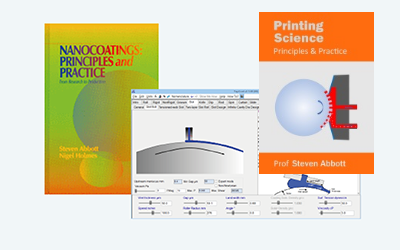Drop Runoff
Quick Start
When a drop is sprayed onto a surface that is tilted at an angle (e.g. an agro spray onto a leaf), will the drop slide down or stay in place? The answer depends on drop diameter, tilt angle, advancing contact angle and, especially, receding contact angle
Drop Runoff
Drop runoff depends on the balance of the gravitational force and the dissipation of energy as the drop rolls off.
The science is old1, but seems to work well. Two equations govern this balance. Where m is the mass of the drop, d is the diameter, γ is the surface tension, α is the runoff angle and the advancing and receding contact angles are θA, θR:
`(m.g.sin(α))/d=γ(cosθ_R-cosθ_A)`
`m/ρ=π(1-cosθ_A)^2(2+cosθ_A)d^3/(24sin^3θ_A`
In the app, α is calculated from the combination of the two equations.
With smaller drops and/or a large receding contact angle, no angle will cause runoff. The significance of the receding contact angle is the unexpected factor in runoff. People worry about how their additives and surfactants affect "contact angle" and they generally use a nice device to measure it. But without an understanding of the receding contact angle effects (a "good" surfactant might cover the surface and give a near-zero contact angle) such measurements are not too useful.
1CGL Furmidge, Studies at Phase Interfaces 1 The Sliding of Liquid Drops on Solid Surfaces, J Colloid Science 17,309-324, 1962


